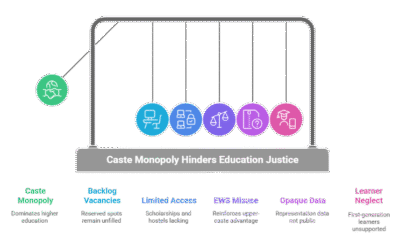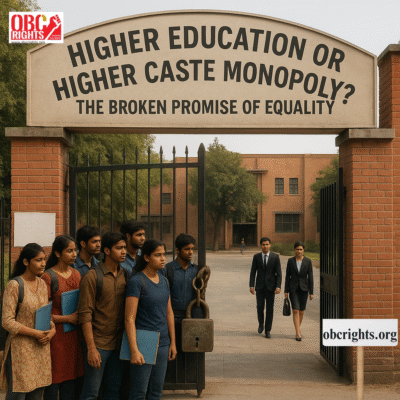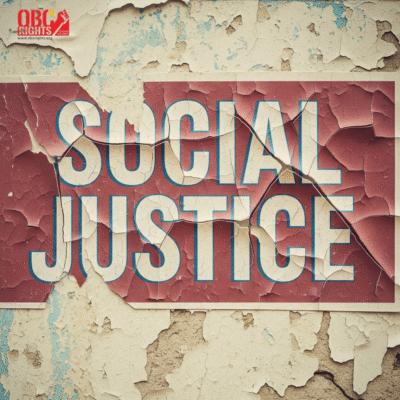India takes pride in its democracy, diversity, and opportunities. Yet, when it comes to higher education, the reality is far from equal. Access to universities and premier institutions has long been controlled by a privileged minority, while the majority — OBCs, SCs, and STs — remain underrepresented. This imbalance raises a disturbing question: are our universities serving the nation or safeguarding advanced communities under the mask of merit?
The Hidden Barriers to Higher Education:
Despite decades of affirmative action, the presence of marginalized groups in top institutions remains far below their share of the population. With a population of over 146 crores, only a small section of Indians manages to enter the country’s top universities. Amongst that, too, the OBC 0 count is negligible.
For OBC, SC, and ST students, the hurdles are not only entrance exams. Students from marginalized groups often encounter caste bias, financial hardships, inadequate hostel infrastructure, and the absence of proper guidance or mentorship. These challenges reduce education from a fundamental right to an exclusive privilege.
By contrast, upper-caste groups — especially Brahmins and other socially advantaged sections — secure admissions disproportionately higher than their numbers justify. This advantage is not simply about talent. It is built upon inherited resources, coaching access, family networks, and centuries of accumulated privilege. Added to this is the EWS quota, designed in the name of fairness but largely benefiting the already dominant castes. The result: a monopoly disguised as meritocracy.

Higher Education or Higher Caste Monopoly? A Reality Check:
The debate is not about denying opportunities to anyone but about ensuring fair representation for all. When OBCs, SCs, and STs are denied access, India loses an enormous pool of talent that could strengthen the nation.
Ironically, those who dominate educational spaces often do not contribute back to the country in proportion to the opportunities they enjoy. Many migrate abroad, seeking high salaries and luxurious lives, while marginalized students, if given the chance, are more likely to stay, work, and serve their families and communities here in India. This disconnect exposes how an unequal system not only harms individuals but also weakens the nation’s potential for genuine progress.
Patriotism and Responsibility: Who Truly Serves the Nation?
It raises a crucial point — who genuinely stands committed to India’s progress? Many from elite castes, after enjoying subsidized education in premier Indian institutions, move abroad, contributing to foreign economies. Instead of working for the country’s progress, their main concern becomes personal prosperity and benefit.
In contrast, marginalized groups tend to remain in India, tied to their families, communities, and the soil of this nation. If higher education truly reflected the diversity of India, we would see a stronger workforce driven not only by personal ambition but also by responsibility and working toward the country’s growth.
Thus, giving rightful space to OBCs, SCs, and STs in higher education is not charity; it is an investment in India’s patriotic lot committed to serve the nation.
The Path Forward: Beyond Words
If India truly wants justice in education, we must first admit the truth: higher education is still captured by an upper caste monopoly. True equality is not about token inclusion; it demands proportional representation. That requires:
- Filling backlog vacancies in reserved categories without delay.
- Expanding scholarships, hostels, and mentorship programs.
- Auditing the EWS quota to ensure it does not reinforce upper-caste advantage. The weaker sections of backward communities must be included.
- Making institutions publish annual representation data, so accountability is public.
- Supporting first-generation learners through guidance, language support, and financial aid.
These are not anti-merit steps. They are essential corrections to centuries of exclusion. True merit can only thrive when all students start on a level playing field.

Final Thoughts
The question remains open: is Indian education serving the nation, or only a privileged few castes? The truth is uncomfortable, but unless we act, the Broken Promise of Equality will continue. India cannot afford to let its institutions remain in the hands of a minority elite.
The future of this country depends on building a system where opportunity is shared, talent is nurtured, and patriotism is practiced by working for India’s progress — not by abandoning it. It is time to demand proportional representation, strengthen reservations, and ensure that higher education belongs to every community, not just a chosen few. Only then can India live up to its promise of equality and justice for all.



